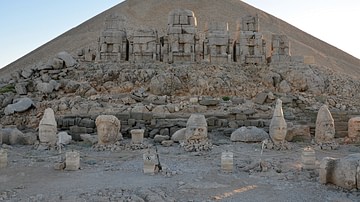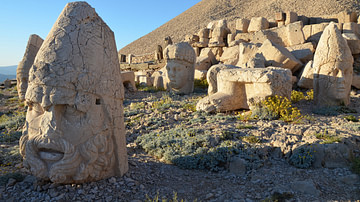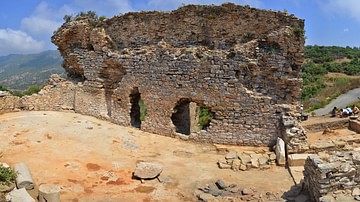Video
by Faces of Ancient Europe
published on 26 August 2020
Mount Nemrut is a monumental site belonging to the Kingdom of Commagene, a small, independent Armenian kingdom that was formed in 162 BCE. This was a period during which the once mighty Seleucid Empire was beginning to disintegrate, allowing certain areas of its empire to break free from the centralised control of the Seleucids. Located in the eastern Taurus mountain range in southern Turkey, near the town of Adiyaman, Mount Nemrut is home to an ancient complex built by the fourth, and arguably the most famous, king of Commagene, Antiochus I Theos (the ‘God King’).
King Antiochus I, ruler of Commagene from 70 BCE to c. 38 BCE, was a most unusual king. He claimed descent from Greek conqueror Alexander the Great on his mother’s side, and from the Persian King Darius I the Great on his father’s side, thus combining the west and the east. But what was particularly salient about this king was his unerring pride and his over-extended ego. Antiochus I claimed he had a special relationship with the gods and instituted a royal cult in the Greek form of the religion Zoroastrianism with the clear intention of being worshipped as a god after his death.
King Antiochus I practised astrology of a very esoteric kind, and laid the basis for a calendrical reform, by linking the Commagene year, which till then had been based on the movements of the Sun and Moon, to the Sothic-Anahit (Star of Sirius) and Hayk (Star of Orion) cycle used by the Egyptians as the basis of their calendar. This would suggest that Antiochus was knowledgeable about, if not fully initiated into Hermeticism.
Antiochus commissioned the construction of a magnificent religious sanctuary on Mount Nemrut (Nemrud Dagi), a 2,100-metre high mountain where people could come and pray to him. Antiochus wanted his sanctuary to be in a high and holy place, close to the gods in order to be in rank with them, and high enough that the whole kingdom could see it and remember him. The tomb-sanctuary was built in 62 BCE and consists of a pyramid-shaped mound of stone chips with a diameter of 145 m and was 50 m in height. Two antique processional routes radiate out from the east and west terraces. The scale of this structure and the amount of labour that was required to build it are impressive on their own. Nevertheless, it is the cultural assimilation reflected in this monument that sets it apart from most other superstructures.
Antiochus’ sanctuary was forgotten for centuries, until it was re-discovered by a German archaeologist in 1883 CE.
License & Copyright
Original video by Faces of Ancient Europe. Embedded by Joshua J. Mark, published on 26 August 2020. Please check the original source(s) for copyright information. Please note that content linked from this page may have different licensing terms.
The video and its description text are provided by Youtube. This website claims no authorship of this content; we are republishing it for educational purposes.
Cite This Work
Chicago Style
Europe, Faces of Ancient. "Mount Nemrut and the God King of Commagene."
World History Encyclopedia. Last modified August 26, 2020.
https://www.worldhistory.org/video/2094/mount-nemrut-and-the-god-king-of-commagene/.
MLA Style
Europe, Faces of Ancient. "Mount Nemrut and the God King of Commagene."
World History Encyclopedia. World History Encyclopedia, 26 Aug 2020, https://www.worldhistory.org/video/2094/mount-nemrut-and-the-god-king-of-commagene/. Web. 25 Apr 2025.




